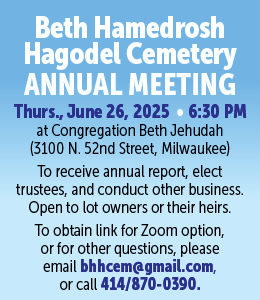“Southern Exposure: The Jews of Argentina” runs through Jan. 17 at Jewish Museum Milwaukee, 1360 N. Prospect Ave.
1. Argentina was a haven, yet a challenge.
The history of Argentina for the Jewish people is mixed. The nation served as a haven for Jews during the late 1800s, during a period starting in the 1920s, and after World War II, but there was also anti-Semitism.
“There were good times and not so good times,” explained Ruben Lewin, 65, a Milwaukee resident who visited the exhibit on opening day with his wife, Silvia. They were both born in Buenos Aires, Argentina.
They didn’t live in fear there, but the anti-Semitism was there, Silvia added. The pair left for Israel and then Milwaukee.
Molly Dubin, curator for Jewish Museum Milwaukee, spoke with local Jews who’ve lived in Argentina in preparing the exhibit. People shared memories of food and family, but also of stories like a swastika carved into a school desk.
2. It started with agriculture.
Some Jewish immigrants first arrived to farm. The exhibit discusses the role of agriculture for arriving Jews, a point of interest for Isaac Flegel-Mishlove, formerly of Shorewood and now of Washington, D.C.
The 22-year-old Georgetown University graduate did a thesis on the Jews of Ecuador and is currently working for HIAS, a refugee aid society. Flegel-Mishlove arrived on opening day of the Argentina exhibit with his mother, Judy Flegel, of Shorewood.
“I’ve always had an interest in the Jews of Latin America,” Flegel-Mishlove said, noting that Jews arrived in Ecuador, at least on paper, to farm.
“It’s interesting to see the similarities between Argentina and what I know about Ecuador.”
3. Message to anti-Semites: Don’t push us around.
Mauricio Arenzon, 75, of Mequon, was in his early 20s in Buenos Aires when Israeli agents there captured Adolf Eichmann, the Nazi war criminal. Eichmann was sentenced to death in Israel and hanged on May 31, 1962.
Arenzon recalls that soon after Eichmann was taken, Nazi sympathizers started antagonizing Jews there.
Arenzon, who was working in Buenos Aires at the time, remembers taking place in a march on Nov. 20, 1962. The message to anti-Semitic elements was this: Don’t push us around. Arenzon says things improved after the march.
Gouchos, or cowboys, were already part of the native population when a wave of Jewish immigration began in the late 1800s. They were ranchers, hired by families to oversee cattle, Dubin said.
As Jews arrived, assisted in their journey from Russia by the Jewish Colonization Association with funding from a banker named Baron Maurice de Hirsch, some worked with livestock and became known as “gauchos Judios.”
An original gaucho outfit, boot spurs and belts are on display at the museum, on loan from Claudio Pelc, a Jewish native of Argentina who now lives in Mequon.
Tango is a partner dance that originated in the late 1800s, along the river Plate, which serves as the border between Argentina and Uruguay.
“There is some sense that the klezmer music may have helped inform the tango,” Dubin said.
“Southern Exposure: The Jews of Argentina” runs through Jan. 17.Museum hours are Monday-Thursday, 10 a.m. – 4 p.m.; Friday, 10 a.m. – 2 p.m.; Saturday, closed; Sunday, 12 – 4 p.m. Visit the Jewish Museum Milwaukee, 1360 N. Prospect Ave. Adults, $6; seniors, $5; students, $3; families, $15; children under 6, free. More info: JewishMuseumMilwaukee.org or 414-390-5730.



